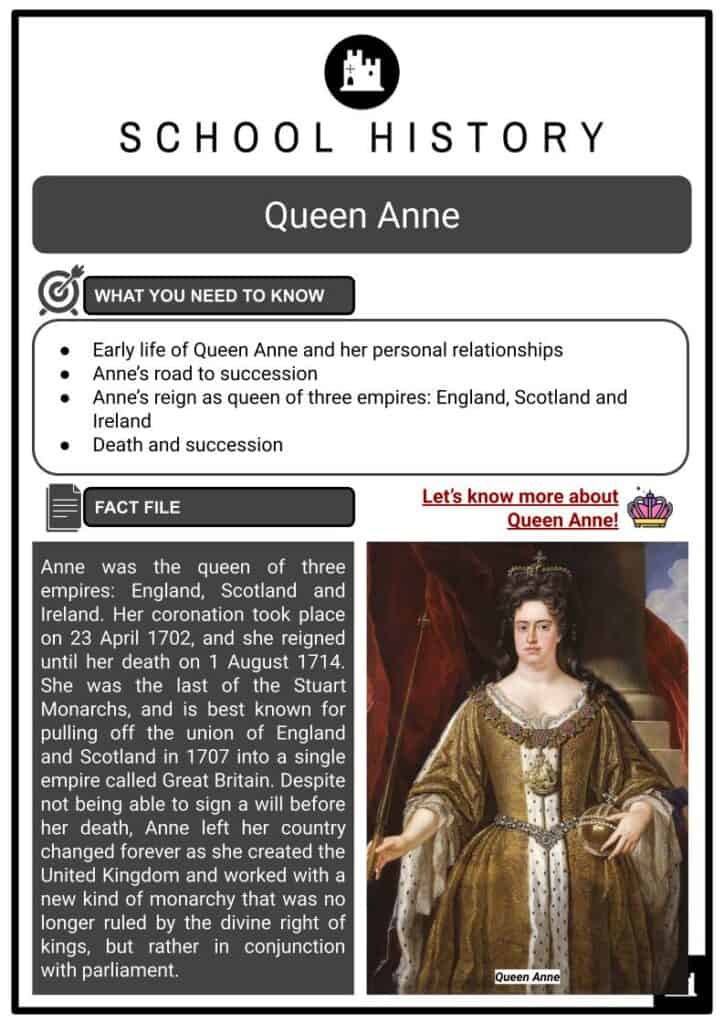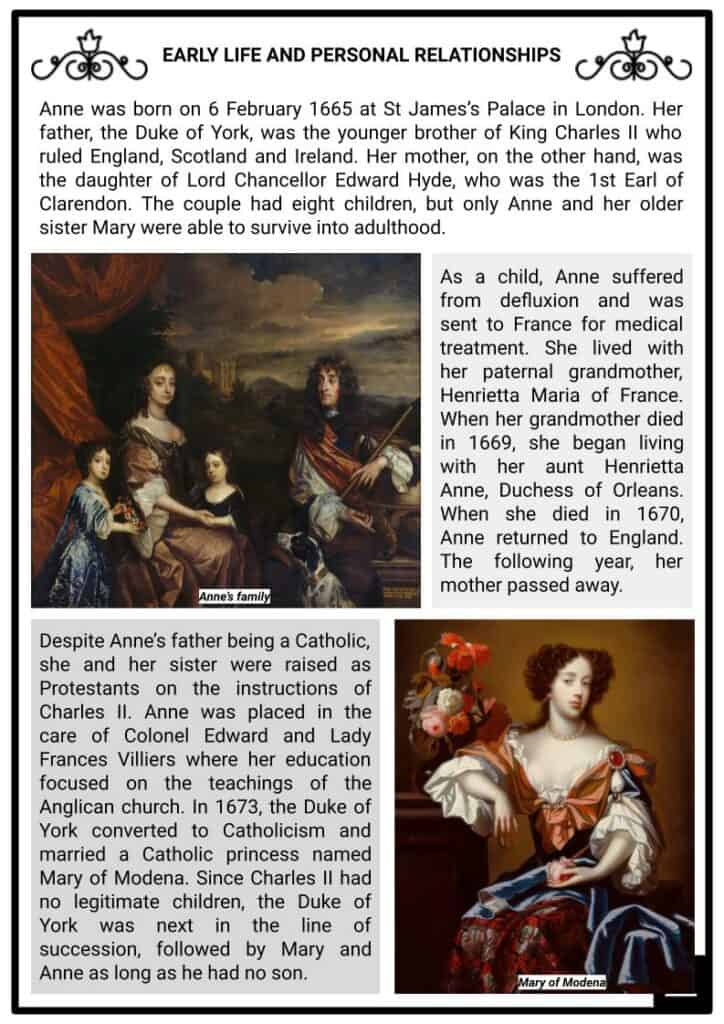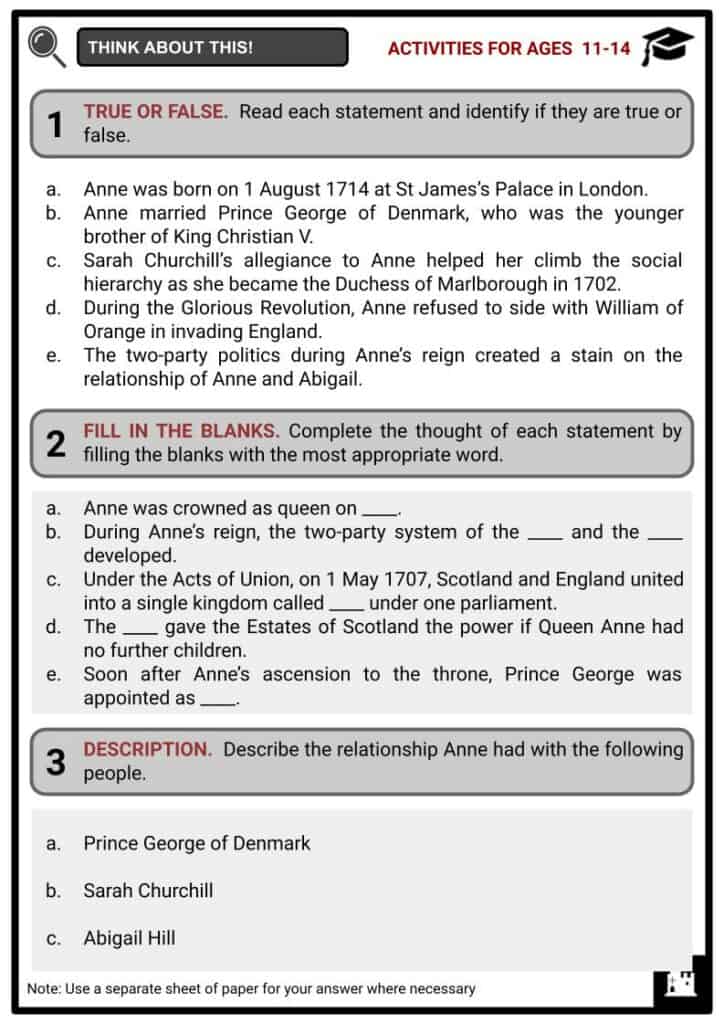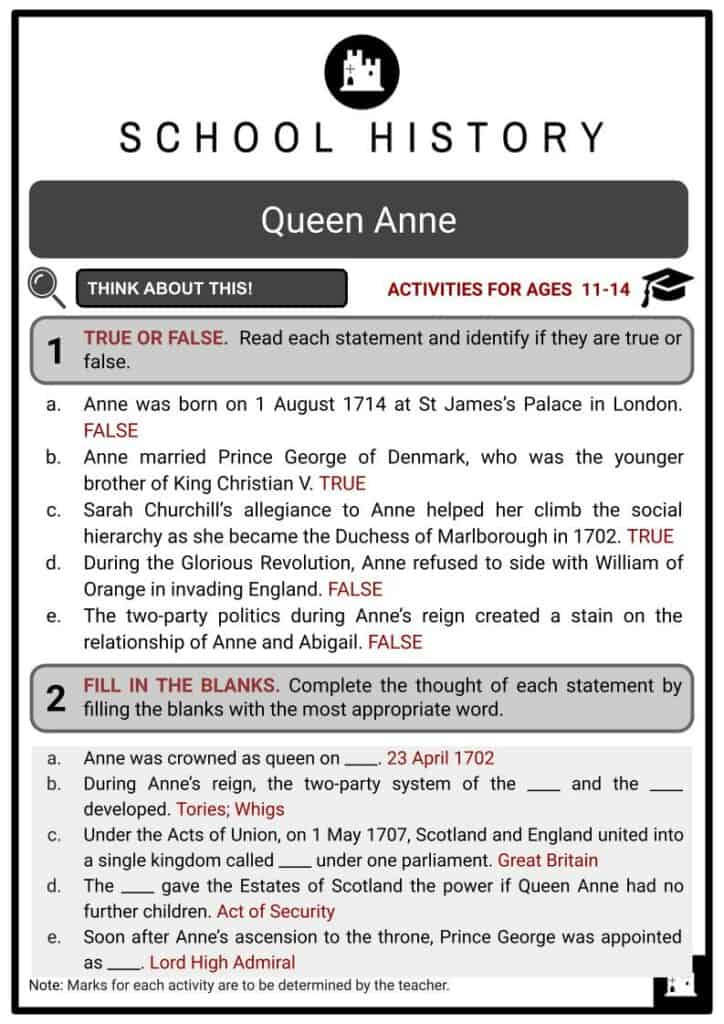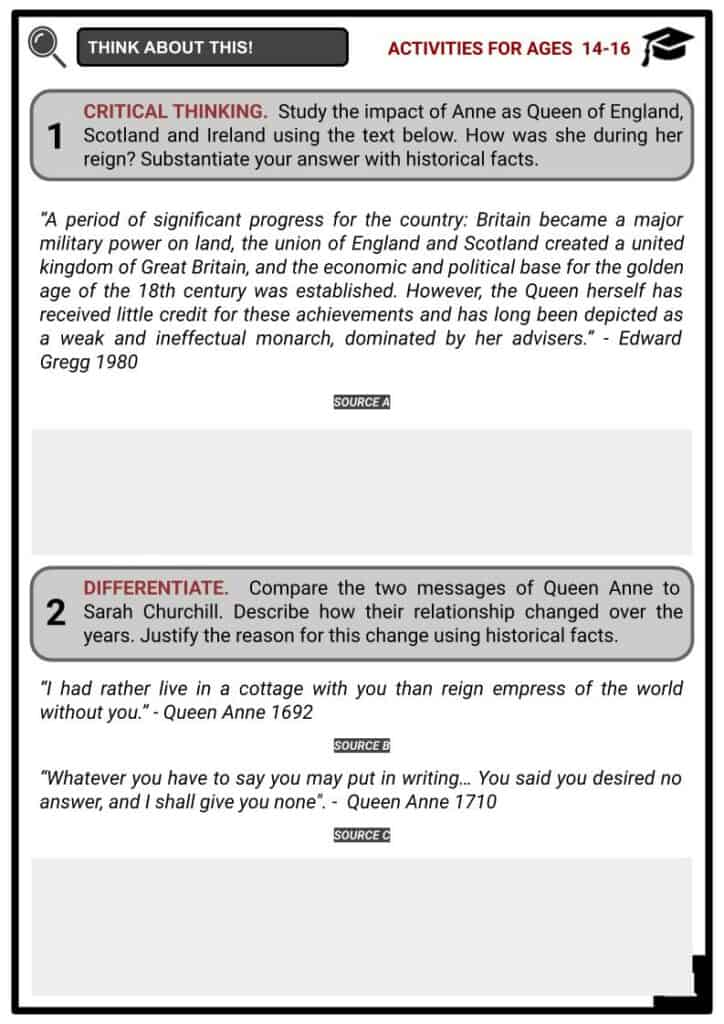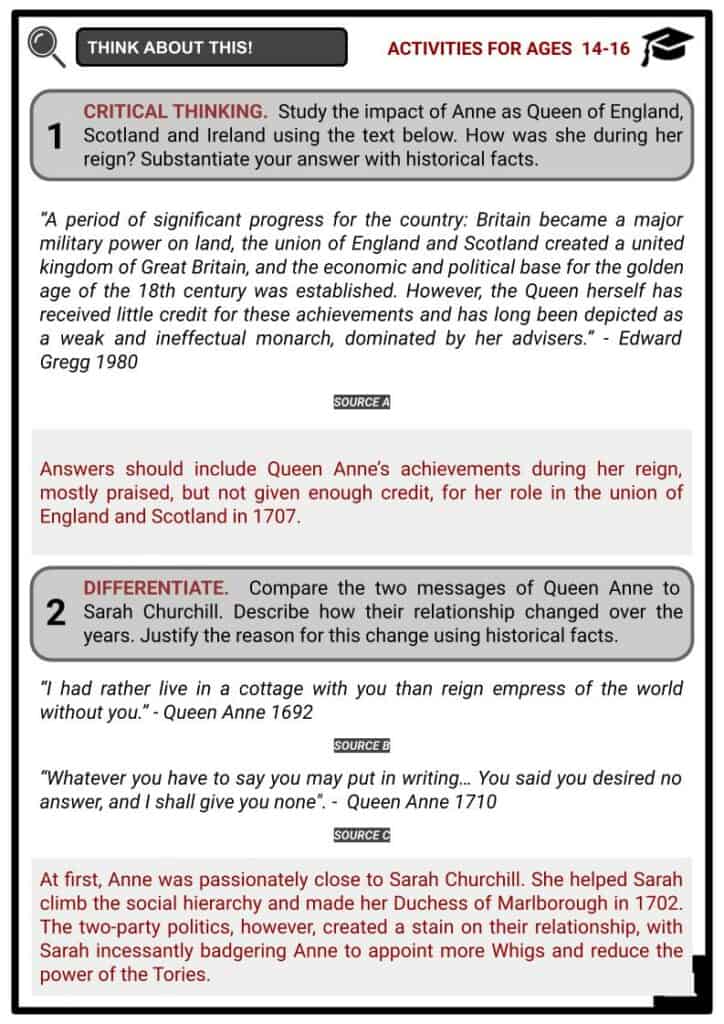Download Queen Anne Worksheets
Do you want to save dozens of hours in time? Get your evenings and weekends back? Be able to teach about Queen Anne to your students?
Our worksheet bundle includes a fact file and printable worksheets and student activities. Perfect for both the classroom and homeschooling!
Summary
- Early life of Queen Anne and her personal relationships
- Anne’s road to succession
- Anne’s reign as queen of three empires: England, Scotland and Ireland
- Death and succession
Key Facts And Information
Let’s know more about Queen Anne!
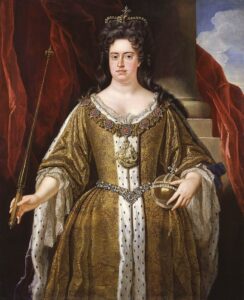
Anne was the queen of three empires: England, Scotland and Ireland. Her coronation took place on 23 April 1702, and she reigned until her death on 1 August 1714. She was the last of the Stuart Monarchs, and is best known for pulling off the union of England and Scotland in 1707 into a single empire called Great Britain. Despite not being able to sign a will before her death, Anne left her country changed forever as she created the United Kingdom and worked with a new kind of monarchy that was no longer ruled by the divine right of kings, but rather in conjunction with parliament.
EARLY LIFE AND PERSONAL RELATIONSHIPS
- Anne was born on 6 February 1665 at St James’s Palace in London. Her father, the Duke of York, was the younger brother of King Charles II who ruled England, Scotland and Ireland. Her mother, on the other hand, was the daughter of Lord Chancellor Edward Hyde, who was the 1st Earl of Clarendon. The couple had eight children, but only Anne and her older sister Mary were able to survive into adulthood.
- As a child, Anne suffered from defluxion and was sent to France for medical treatment. She lived with her paternal grandmother, Henrietta Maria of France. When her grandmother died in 1669, she began living with her aunt Henrietta Anne, Duchess of Orleans. When she died in 1670, Anne returned to England. The following year, her mother passed away.
- Despite Anne’s father being a Catholic, she and her sister were raised as Protestants on the instructions of Charles II. Anne was placed in the care of Colonel Edward and Lady Frances Villiers where her education focused on the teachings of the Anglican church. In 1673, the Duke of York converted to Catholicism and married a Catholic princess named Mary of Modena. Since Charles II had no legitimate children, the Duke of York was next in the line of succession, followed by Mary and Anne as long as he had no son.
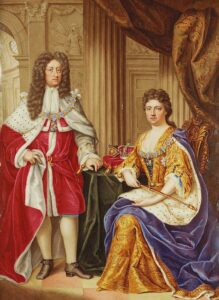
When the time came that Anne needed to be wed, King Charles looked for an eligible prince who would be welcomed by his Protestant subjects and accepted by his Catholic ally, Louis XIV of France. A marriage treaty then came between Anne and Prince George of Denmark, who was the younger brother of King Christian V.
- On 28 July 1683, the two wed in the Chapel Royal at St James’s Palace. Despite being an arranged marriage, the couple were faithful and devoted to each other. Aside from her husband, Anne was also passionately close to Sarah, the daughter of an impoverished gentry family and a maid of honour to Mary of Modena.
- When Sarah met John Churchill at court, they developed a relationship, which eventually led to a secret marriage in the winter of 1677-78. Sarah’s allegiance to Anne and John’s talent as a military commander helped the couple climb the social hierarchy as they became the Duke and Duchess of Marlborough in 1702.
ROAD TO SUCCESSION
- Anne’s father became King James II of England and VII of Scotland after Charles II died in 1685. Upon succeeding the throne, James began to give Catholics military and administrative offices, much to the dismay of the English people. Anne despised the Catholics, saying that “the Church of Rome is wicked and generous,” so she rebelled when James tried to get her youngest daughter into the Catholic faith. Anne soon alienated herself from her father and stepmother.
- Public outrage over James’s Catholicism increased when Mary of Modena became pregnant for the first time since James succeeded to the throne. Anne raised suspicions that the queen was faking her pregnancy in an attempt to introduce a false heir but this wasn’t proven to be true.
Glorious Revolution
- On 5 November 1688, the Glorious Revolution took place as William III of Orange invaded England. Anne refused to side with her father James and instead wrote to William on 18 November to declare her approval of his action. After James fled to France on 23 December, a Convention Parliament assembled in England in January 1689 to declare that James had effectively abdicated when he fled and that England and Ireland’s throne were therefore vacant.
William and Mary
- Anne’s sister Mary and her husband William were declared monarchs of all three realms under the Bill of Rights and Claim of Right Act in 1689. Anne and her descendants would be next in the line of succession, followed by any descendants of William by a future marriage. On 24 July 1689, Anne gave birth to a son, Prince William Duke of Gloucester, who would have eventually inherited the crown if he hadn’t died when he was 11 years old due to an illness.
- After William and Mary’s accession, Anne requested the use of Richmond Palace and a parliamentary allowance, to which the couple refused, thus causing tension between the two sisters. Anne’s resentment grew more when William refused to allow Prince George to serve in the military.
-
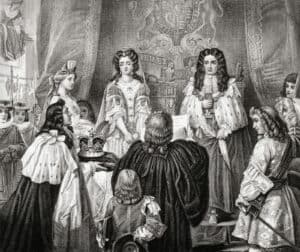
William and Mary For the king and queen, Anne’s financial independence posed a threat that would weaken their influence over the empire and allow Anne to organise a rival political faction.
- Mary soon suspected Anne’s closest friend and influential adviser, Sarah Churchill, of secretly conspiring with the Jacobites who were James’s followers. She ordered her to be removed from the royal household, to which Anne angrily opposed. After Sarah’s dismissal, Anne left her royal lodgings and took up residence at Syon House. Consequently, she was stripped of her guard of honour with civic authorities instructed to ignore her. The sisters never saw each other again as Mary died of smallpox in 1694. William continued to reign alone after the death of his wife. Since Anne was the apparent heir, the two reconciled publicly with William restoring her previous honours.
- Anne, who had been pregnant at least seventeen times already, had her final pregnancy on 25 January 1700, however it was a stillbirth. Her pregnancies did not help her already deteriorating health. Out of all her seventeen births, only William, Duke of Gloucester survived but died eleven years later.
- With no heir and Anne being the only individual remaining in the line of succession under the Bill of Rights 1689, the Act of Settlement 1701 was enacted by the Parliament of England. The act provided that failing the issue of Anne and of William III by any future marriage, the Crown of England and Ireland would go to Sophia, Electress of Hanover, and her Protestant descendants.
REIGN
-
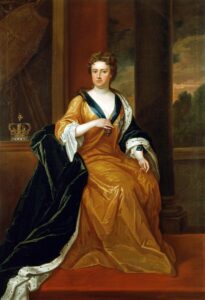
Queen Anne Upon the death of King William III on 8 March 1702, Anne became queen. She immediately became popular after her first speech to the English Parliament: “As I know my heart to be entirely English, I can very sincerely assure you there is not anything you can expect or desire from me which I shall not be ready to do for the happiness and prosperity of England.” She was crowned on 23 April 1702 on St. George’s Day. Afflicted with gout, she had to be carried to Westminster Abbey.
- Soon after her accession, she appointed the following people:
- Prince George as Lord High Admiral who had nominal control of the Royal Navy
- Lord Marlborough as Captain-General who had control of the army; he was also created a Knight of the Garter elevating him to the rank of duke
- Duchess of Marlborough as Groom of the Stool, Mistress of the Robes, and Keeper of the Privy Purse
Acts of Union
- In October 1702, she discussed terms to conclude a union of England and Scotland. Negotiations, however, broke up in early February 1703 because of failure to reach an agreement.
- The Estates of Scotland passed the Act of Security as a response to the Act of Settlement. The act gave the Estates the power if Queen Anne had no further children. Initially, Anne withheld royal assent to the act. However, because the Estates threatened to withhold supply for England’s wars, she granted the act the following year.
- In response, the English Parliament responded with the Alien Act 1705 that threatened to impose economic sanctions and declare Scottish subjects aliens in England, unless Scotland moved to unite with England or repeal the Act of Security. With the Estates agreeing on the former, the English Parliament agreed to repeal the Alien Act and negotiations to form the union followed.
- Articles of the Union were ratified by the Scottish and English Parliaments on 16 January and 6 March 1707, respectively. Under the Acts of Union, on 1 May 1707, Scotland and England united into a single kingdom called Great Britain under one parliament.
Two-Party Politics
- During Anne’s reign, the two-party system of the Tories and the Whigs developed. The Tories were supportive of the Anglican church and favoured the landed interest of the country gentry. The Whigs, on the other hand, were aligned with commercial interest and Protestant Dissenters. Since Anne was a committed Anglican, she was in favour of the Tories.
-
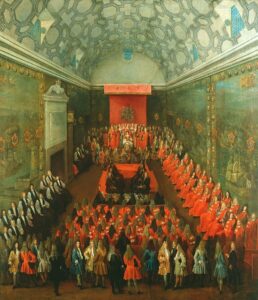
Queen Anne addressing the House of Lords Anne also supported the Occasional Conformity Bill of 1702 promoted by the Tories. The bill was opposed by the Whigs as it aimed to disqualify Protestant Dissenters from public office. If non-conformists were to take Anglican communion once a year, they would be permitted to take office. The bill, however, was successfully blocked by the Whigs after three failed attempts of the Tories.
- The Whigs also vigorously supported the War of the Spanish Succession. Many Tories opposed British involvement in the land war against France.
- The two-party politics during Anne’s reign created a stain on the relationship of Anne and Sarah, with the latter incessantly badgering Anne to appoint more Whigs and reduce the power of the Tories. During her discontentment with Sarah, Anne turned to Abigail Hill, a woman of the bedchamber whose influence grew as Anne's relationship with Sarah deteriorated.
- In October 1708, George died, which caused great devastation for his wife Anne. The Whigs were able to use his death to their advantage since they were now dominant in the Parliament.
- With Anne distraught at the loss of her husband, the Whigs forced her to accept the Junto leaders Lords Somers and Wharton into the cabinet. Anne, however, insisted on carrying out the duties of her late husband who was Lord High Admiral. Junto demanded the appointment of Earl of Orford as First Lord of the Admiralty, to which Anne responded by appointing the Earl of Pembroke on 29 November 1708.
- This resulted in more tension between her and the Junto Whigs. When Pembroke resigned after less than a year in office, Anne finally consented to put Orford as First Lord of the Admiralty in November 1709.
DEATH AND SUCCESSION
- Between January and July 1713, Anne was unable to walk because of her illness. Later on she became too ill to attend cabinet meetings. On 30 July 1714, she was rendered unable to speak by a stroke. This led to rumours of her impending death.
- On 1 August 1714, Anne passed away. She was buried on 24 August beside her husband and children at the Henry VII Chapel on the South Aisle of Westminster Abbey. The Electress Sophia’s son George, Elector of Hanover, succeeded the throne pursuant to the Act of Settlement 1701.
Image Sources
- https://upload.wikimedia.org/wikipedia/commons/thumb/5/5d/Closterman%2C_John_-_Queen_Anne_-_NPG_215.jpg/800px-Closterman%2C_John_-_Queen_Anne_-_NPG_215.jpg
- https://upload.wikimedia.org/wikipedia/commons/7/74/Charles_Boit%2C_Queen_Anne_and_Prince_George_crop.jpg
- https://cdn.britannica.com/98/192398-050-D5FE548B/Parliament-crown-William-and-Mary-February-1689.jpg
- https://upload.wikimedia.org/wikipedia/commons/thumb/f/f7/Queen_Anne_of_Great_Britain.jpg/800px-Queen_Anne_of_Great_Britain.jpg
- https://upload.wikimedia.org/wikipedia/commons/thumb/0/09/Peter_Tillemans_%28c._1684-1734%29_-_Queen_Anne_%281665-1714%29_in_the_House_of_Lords_-_RCIN_405301_-_Royal_Collection.jpg/800px-Peter_Tillemans_%28c._1684-1734%29_-_Queen_Anne_%281665-1714%29_in_the_House_of_Lords_-_RCIN_405301_-_Royal_Collection.jpg

